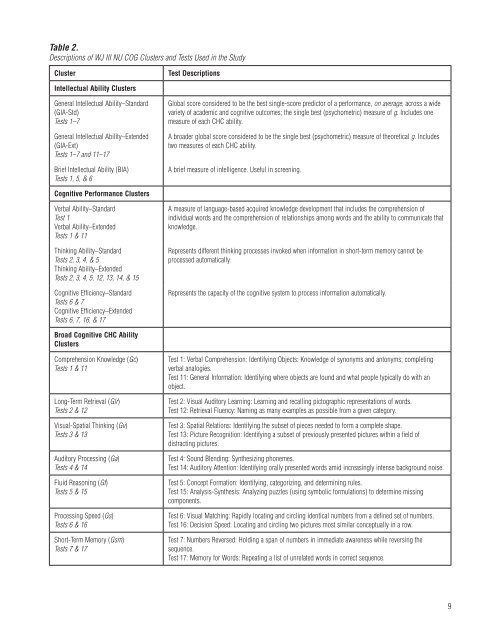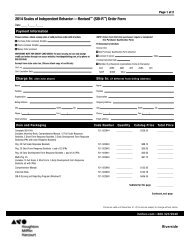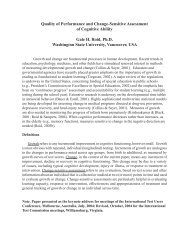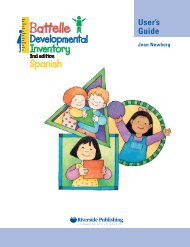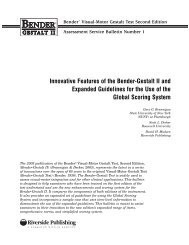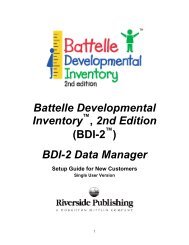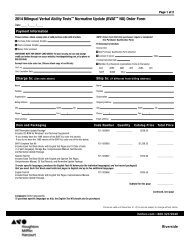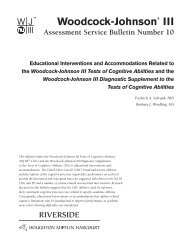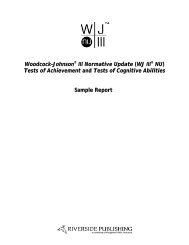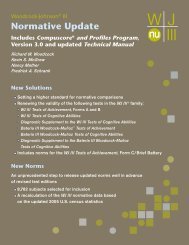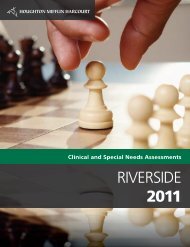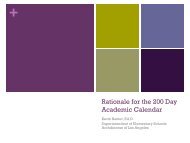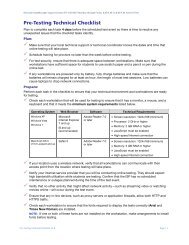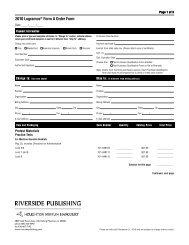Woodcock-Johnson® III - Riverside Publishing
Woodcock-Johnson® III - Riverside Publishing
Woodcock-Johnson® III - Riverside Publishing
- No tags were found...
Create successful ePaper yourself
Turn your PDF publications into a flip-book with our unique Google optimized e-Paper software.
Table 2.Descriptions of WJ <strong>III</strong> NU COG Clusters and Tests Used in the StudyClusterTest DescriptionsIntellectual Ability ClustersGeneral Intellectual Ability–Standard(GIA-Std)Tests 1–7General Intellectual Ability–Extended(GIA-Ext)Tests 1–7 and 11–17Brief Intellectual Ability (BIA)Tests 1, 5, & 6Global score considered to be the best single-score predictor of a performance, on average, across a widevariety of academic and cognitive outcomes; the single best (psychometric) measure of g. Includes onemeasure of each CHC ability.A broader global score considered to be the single best (psychometric) measure of theoretical g. Includestwo measures of each CHC ability.A brief measure of intelligence. Useful in screening.Cognitive Performance ClustersVerbal Ability–StandardTest 1Verbal Ability–ExtendedTests 1 & 11Thinking Ability–StandardTests 2, 3, 4, & 5Thinking Ability–ExtendedTests 2, 3, 4, 5, 12, 13, 14, & 15Cognitive Efficiency–StandardTests 6 & 7Cognitive Efficiency–ExtendedTests 6, 7, 16, & 17A measure of language-based acquired knowledge development that includes the comprehension ofindividual words and the comprehension of relationships among words and the ability to communicate thatknowledge.Represents different thinking processes invoked when information in short-term memory cannot beprocessed automatically.Represents the capacity of the cognitive system to process information automatically.Broad Cognitive CHC AbilityClustersComprehension Knowledge (Gc)Tests 1 & 11Long-Term Retrieval (Glr)Tests 2 & 12Visual-Spatial Thinking (Gv)Tests 3 & 13Auditory Processing (Ga)Tests 4 & 14Fluid Reasoning (Gf)Tests 5 & 15Processing Speed (Gs)Tests 6 & 16Short-Term Memory (Gsm)Tests 7 & 17Test 1: Verbal Comprehension: Identifying Objects: Knowledge of synonyms and antonyms; completingverbal analogies.Test 11: General Information: Identifying where objects are found and what people typically do with anobject.Test 2: Visual Auditory Learning: Learning and recalling pictographic representations of words.Test 12: Retrieval Fluency: Naming as many examples as possible from a given category.Test 3: Spatial Relations: Identifying the subset of pieces needed to form a complete shape.Test 13: Picture Recognition: Identifying a subset of previously presented pictures within a field ofdistracting pictures.Test 4: Sound Blending: Synthesizing phonemes.Test 14: Auditory Attention: Identifying orally presented words amid increasingly intense background noise.Test 5: Concept Formation: Identifying, categorizing, and determining rules.Test 15: Analysis-Synthesis: Analyzing puzzles (using symbolic formulations) to determine missingcomponents.Test 6: Visual Matching: Rapidly locating and circling identical numbers from a defined set of numbers.Test 16: Decision Speed: Locating and circling two pictures most similar conceptually in a row.Test 7: Numbers Reversed: Holding a span of numbers in immediate awareness while reversing thesequence.Test 17: Memory for Words: Repeating a list of unrelated words in correct sequence.9


